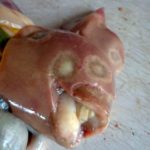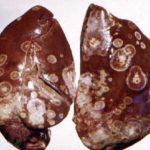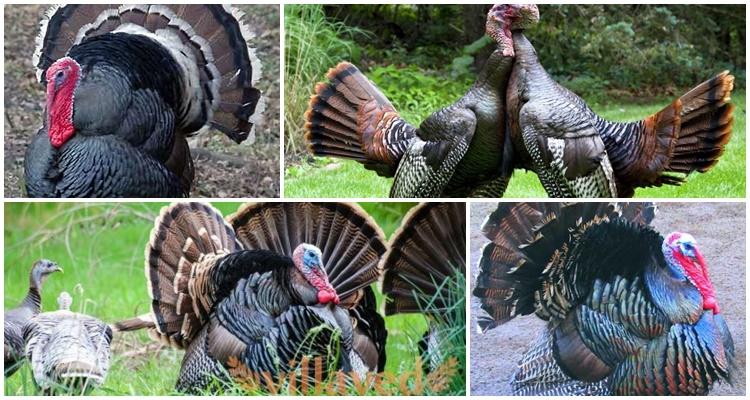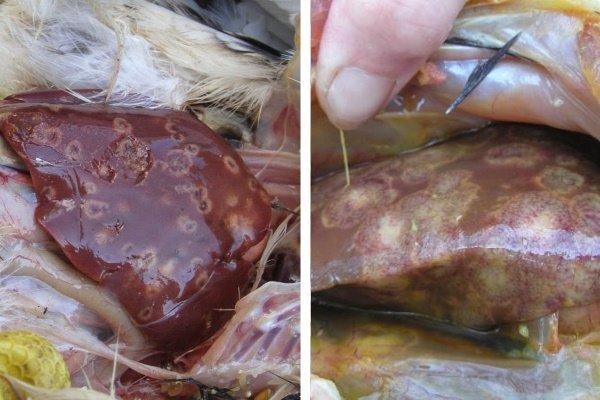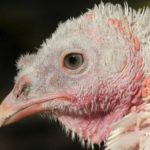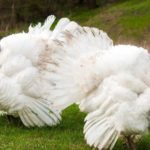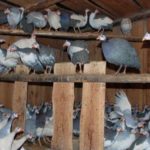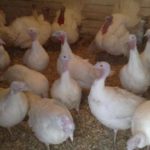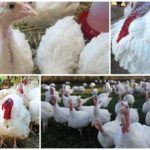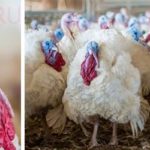Histomoniasis is an infectious disease caused by protozoa. They parasitize in the intestines, liver, kidneys and spleen of birds. Under the influence of toxins, inflammatory processes begin in the body. If sick turkeys will not be given treatment, tissue necrosis develops, which can be determined by darkening of the skin on the head. Let's look at the causes and symptoms of histomoniasis in turkeys, its treatment and prevention.
Pathogen and causes of the disease
The causative agents of the disease are the protozoa histomonas.They are transmitted to healthy turkeys from sick turkeys through contact; wild birds can also be the source. Histomonad carriers can be insects and earthworms, which turkeys find in the pasture. Birds can become infected from external parasites - lice and fleas, rodents, and other poultry - chickens, ducks.
Protozoa can be found in dirty bedding, drinkers and feeders used by sick birds. Histomonas can be carried by the owner himself - on shoes, clothes and hands.
Symptoms and forms of the disease
The disease occurs in acute and chronic forms. In its acute form, histomonosis mainly affects turkey poults up to 3 months of age. The incubation period lasts up to 3 weeks. A characteristic sign of histomoniasis is darkening of the skin, which is clearly visible on the head, where there are no feathers. But this already indicates irreparable changes in the body. It is impossible to save the bird at this stage of the disease, so treatment is not prescribed.
Before the characteristic sign appears, other symptoms may be noticed. But they are not unique to histomonosis, but are similar to the signs of many infectious diseases. Sick turkeys become lethargic, do not eat, move little, and when trying to stand on their feet, they stagger and fall.
Symptoms of histomonosis: diarrhea, changes in the color and smell of the droppings, it becomes brown with a greenish tint, and smells unpleasant. In birds, body temperature decreases to 37.9 ˚С compared to normal 39.9-41.8 ˚С. In the chronic form, the symptoms of the disease are vague and not clearly expressed.
Pathological changes
Up to 100% of the population can become infected with protozoa, and a mortality rate of 70% can be expected. An autopsy reveals the following abnormalities: the intestinal walls are enlarged, their surface is bumpy and covered with a marble pattern.The large intestines can grow together with the small intestines; there is a brownish liquid in the lumen of the intestines.
Diagnostic rules
The disease can be identified by the plumage, which becomes dull and falls out. The scalp darkens and becomes almost black. The diagnosis of histomoniasis is made on the basis of external symptoms, pathological changes and examination of liver tissue and intestinal contents of sick turkeys. When making a diagnosis, it is necessary to exclude coccidiosis, tuberculosis, typhus, trichomoniasis, leukemia, and coligranulomatosis.
Treatment methods for histomoniasis in turkeys
Sick turkeys, in most cases, die. Those who have recovered from the disease develop immunity. Histomoniasis can be treated only at an early stage. Antibiotics are used for therapy. All turkeys on the farm are subject to preventive treatment, even if they do not show signs of the disease.
Birds that show symptoms are moved separately to another room and left there until they recover. Where there were sick birds, disinfection is carried out, the bedding is completely changed, drinkers and feeders, perches and nests are cleaned and disinfected.
Treatment big-6 cross turkeys, other crosses and breeds are carried out with the help of antibiotics and anti-inflammatory drugs. They use, for example, “Metronidazole”, “Trichopol” in powder or tablets. The medicine is administered in food or drinking water. The course of treatment is 9 days. Then for the same number of days it is necessary to do preventive feeding with solutions of drugs with a dosage recommended for healthy turkeys. After 3 weeks, preventive treatment is repeated.
To restore the intestinal microflora after the end of antibacterial therapy, turkeys are given probiotics, and to strengthen the immune system - vitamin preparations. During the recovery period, they are fed mash with the inclusion of greens or complete feed.
Sick turkeys in the late stages of histomonosis are slaughtered and disposed of. Carcasses need to be burned or buried. Meat and internal organs should not be fed to domestic animals. Meat from apparently healthy turkeys is also unsuitable for human consumption; it can be infected with histomonas. Therefore, you also need to get rid of the meat of suspicious birds.
Prevention
Raising young stock on mesh or slatted floors to minimize contact with droppings. Periodic feeding of livestock with solutions of antibiotics and protisticides, anthelmintics. Destruction of rodents and insects on the farm territory, limiting contacts of turkeys with birds from other farms. Quarantine new turkeys. Cleaning and disinfection of turkey poultry, working equipment, drinking bowls and feeders.
Histomoniasis is not dangerous for humans, but you need to wear gloves when working, and after cleaning and disinfecting the room, change and disinfect your clothes.
Histomoniasis of turkeys is an infectious disease that, when introduced on a farm, can infect the entire livestock. In this case, treatment cannot be avoided. The diagnosis must be made by a veterinarian, who also selects medications and treatment regimens. You cannot make a diagnosis on your own, based only on external signs. How to treat turkeys with antibiotics, which may be ineffective due to incorrect diagnosis.

